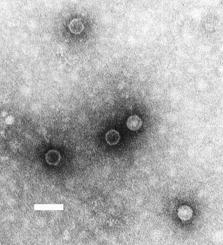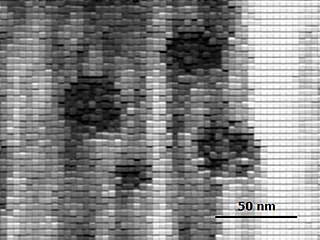
Parvoviruses are a family of animal viruses that constitute the family Parvoviridae. They have linear, single-stranded DNA (ssDNA) genomes that typically contain two genes encoding for a replication initiator protein, called NS1, and the protein the viral capsid is made of. The coding portion of the genome is flanked by telomeres at each end that form into hairpin loops that are important during replication. Parvovirus virions are small compared to most viruses, at 23–28 nanometers in diameter, and contain the genome enclosed in an icosahedral capsid that has a rugged surface.

A poliovirus, the causative agent of polio, is a serotype of the species Enterovirus C, in the family of Picornaviridae. There are three poliovirus serotypes: types 1, 2, and 3.

Picornaviruses are a group of related nonenveloped RNA viruses which infect vertebrates including fish, mammals, and birds. They are viruses that represent a large family of small, positive-sense, single-stranded RNA viruses with a 30 nm icosahedral capsid. The viruses in this family can cause a range of diseases including the common cold, poliomyelitis, meningitis, hepatitis, and paralysis.

Bunyavirales is an order of segmented negative-strand RNA viruses with mainly tripartite genomes. Member viruses infect arthropods, plants, protozoans, and vertebrates. It is the only order in the class Ellioviricetes. The name Bunyavirales derives from Bunyamwera, where the original type species Bunyamwera orthobunyavirus was first discovered. Ellioviricetes is named in honor of late virologist Richard M. Elliott for his early work on bunyaviruses.

Birnaviridae is a family of double-stranded RNA viruses. Salmonid fish, birds and insects serve as natural hosts. There are currently 11 species in this family, divided among seven genera. Diseases associated with this family include infectious pancreatic necrosis in salmonid fish, which causes significant losses to the aquaculture industry, with chronic infection in adult salmonid fish and acute viral disease in young salmonid fish.

Dicistroviridae is a family of viruses in the order Picornavirales. Invertebrates, including aphids, leafhoppers, flies, bees, ants, and silkworms, serve as natural hosts. There are 15 species in this family, assigned to three genera. Diseases associated with this family include: DCV: increased reproductive potential. extremely pathogenic when injected with high associated mortality. CrPV: paralysis and death.

Cardiovirus are a group of viruses within order Picornavirales, family Picornaviridae. Vertebrates serve as natural hosts for these viruses.

Deformed wing virus (DWV) is an RNA virus, one of 22 known viruses affecting honey bees. While most commonly infecting the honey bee, Apis mellifera, it has also been documented in other bee species, like Bombus terrestris, thus, indicating it may have a wider host specificity than previously anticipated. The virus was first isolated from a sample of symptomatic honeybees from Japan in the early 1980s and is currently distributed worldwide. It is found also in pollen baskets and commercially reared bumblebees. Its main vector in A. mellifera is the Varroa mite. It is named after what is usually the most obvious deformity it induces in the development of a honeybee pupa, which is shrunken and deformed wings, but other developmental deformities are often present.

Marnaviridae is a family of positive-stranded RNA viruses in the order Picornavirales. The first species of this family that was isolated is Heterosigma akashiwo RNA virus (HaRNAV) in the genus Marnavirus, that infects the toxic bloom-forming Raphidophyte alga, Heterosigma akashiwo. Using a sequence-based framework an additional twenty marine RNA viruses have been added to the family.

Ascoviridae is a family of double strand DNA viruses that infect primarily invertebrates, mainly noctuids and spodoptera species; it contains two genera, Ascovirus, which contains three species, and Toursvirus with a single species Diadromus pulchellus toursvirus.
Endornaviridae is a family of viruses. Plants, fungi, and oomycetes serve as natural hosts. There are 31 species in this family, assigned to 2 genera. Members of Alphaendornavirus infect plants, fungi and the oomycete Phytophthora sp., members of Betaendornavirus infect ascomycete fungi.
Cricket paralysis virus (CrPV) was initially discovered in Australian field crickets by Carl Reinganum and his colleagues at the Victorian Plant Research Institute. The paralytic disease spread rapidly through a breeding colony as well as through a laboratory population causing about 95% mortality. This was the first recorded isolate of the virus and is generally referred to as CrPVvic to distinguish it from subsequent isolates.

Virgaviridae is a family of positive-strand RNA viruses. Plants serve as natural hosts. The name of the family is derived from the Latin word virga (rod), as all viruses in this family are rod-shaped. There are currently 59 species in this family, divided among seven genera.
Dinocampus coccinellae paralysis virus (DcPV) is a single-stranded, positive-sense RNA virus of insects, in the picorna-like virus family Iflaviridae, which was first characterised in 2015. It asymptomatically infects the parasitic braconid wasp, Dinocampus coccinellae, and has been proposed to be associated with the paralytic effect the wasp has on its host, the spotted lady beetle, Coleomegilla maculata, which it turns into a so-called "zombie bodyguard" for its pupa.
Alphabaculovirus is a genus of viruses in the family Baculoviridae. The natural hosts of species in this family are invertebrates, among them winged insects, and decapods. However, species in this genus have been isolated only from Lepidoptera. There are 56 species in the genus.

Alphanodavirus is a genus of non-enveloped positive-strand RNA viruses in the family Nodaviridae. Insects, mammals, and fishes serve as natural hosts. Diseases associated with this genus include: Nodamura virus paralysis in infected wax moth larvae. Member viruses can also provoke paralysis and death to suckling mice and suckling hamsters. There are five species in this genus.

Slow bee paralysis virus (SBPV) is a virus discovered in England in 1974 that infects honeybees, bumblebees, and silkworms through Varroa destructor mite infestations. The virus causes paralysis in the front two pairs of legs of adult bees eventually killing its hosts. The virus is in the iflaviridae family of viruses. Infection by iflaviridae viruses is among the leading cause of death of honeybee colonies. As bees and silkworms are of great economic and biological importance, the virus is the subject of ongoing research.
Triatoma virus (TrV) is a virus belonging to the insect virus family Dicistroviridae. Within this family, there are currently 3 genera and 15 species of virus. Triatoma virus belongs to the genus Cripavirus. It is non-enveloped and its genetic material is positive-sense, single-stranded RNA. The natural hosts of triatoma virus are invertebrates. TrV is a known pathogen to Triatoma infestans, the major vector of Chagas disease in Argentina which makes triatoma virus a major candidate for biological vector control as opposed to chemical insecticides. Triatoma virus was first discovered in 1984 when a survey of pathogens of triatomes was conducted in the hopes of finding potential biological control methods for T. infestans.

The black queen cell virus (BQCV) is a virus that infects honey bees, specifically Apis mellifera, Apis florea, and Apis dorsata. Infection of the latter two species is more recent and can be attributed to genetic similarity and geographical closeness. It is important to learn about this virus because it is one of the most common bee viruses and bees are the most important pollinators. The agricultural industry depends on the bee's pollination to increase its economic value.
Nucleocytoviricota is a phylum of viruses. Members of the phylum are also known as the nucleocytoplasmic large DNA viruses (NCLDV), which serves as the basis of the name of the phylum with the suffix -viricota for virus phylum. These viruses are referred to as nucleocytoplasmic because they are often able to replicate in both the host's cell nucleus and cytoplasm.

















